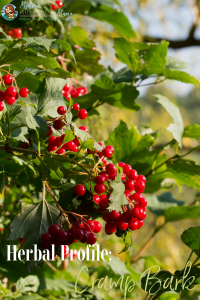By Sarena-Rae Santos, Natural Health Blogger
What is Cramp Bark
Cramp bark’s name comes from its use as a pain treatment for menstrual cramps, but its real name is guelder rose. Guelder rose is a large shrub that grows between 5 and 10 feet tall. In the spring and summer months, large, 3 to 5-inch, flat-topped clusters of snow-white flowers appear. In August, drooping clusters of oval, shiny, translucent berries appear–these are edible but have a bitter taste. Then there’s the faintly cracked, grayish-brown cramp bark, which can be identified by its scattered brown-colored warts, strong odor, and bitter, astringent taste (1).
Health Benefits of Cramp Bark
Cramp bark’s dried bark has been used to treat pain from muscle cramps, especially period cramps, amongst many other health benefits, including:
Antioxidant Properties
Antioxidants can help fight damage from harmful free radicals. The buildup of free radicals has been linked to chronic diseases, such as cancer and heart disease (2). Studies have found that cramp bark contains antioxidants like flavonoids and carotenoids. Studies have found flavonoids and carotenoids can help prevent and reverse cellular damage in your body (3,4).
Anti-Inflammatory Properties
Chronic inflammation has been linked with many diseases, such as type 2 diabetes, asthma, and certain cancers (5). Cramp bark has anti-inflammatory properties. Several studies have found cramp bark decreases inflammation and intracellular oxidative stress while inducing DNA repair without affecting the growth inhibition of lactic acid-beneficial microorganisms (6,7).
May Help Relieve Premenstrual Symptoms (PMS)
For many women, headaches, bloating, cramps, mood swings, pain, and food cravings will occur during or before their menstrual cycle. For other women, moderate to severe physical and emotional changes are experienced, known as premenstrual syndrome (PMS). PMS is also associated with mood swings, tender breasts, food cravings, fatigue, irritability, and depression (8). Studies show that upwards of 90 percent of women report experiencing disturbing PMS symptoms (9).
Cramp bark can help with these uncomfortable symptoms. One study found cramp bark supplementation, among other ingredients, reduces symptoms of PMS (10). Studies illustrate that cramp bark helps relieve pain and even supports female hormones (11). A final study found that the antioxidants in cramp bark may help treat endometriosis (12).
May Support Kidney Health
The kidneys are most known for their responsibility to remove waste products and excess fluid from the body through urination to maintain a stable balance of its natural chemicals. This function is needed due to the importance of regulating the body’s salt, potassium, and acid content, all performed by the two kidneys (13). For some people, low urinary citrate is a risk factor for developing kidney stones (14).
Studies show cramp bark is high in citrate, making it a viable option for those prone to developing kidney stones (15). One study found cramp bark extract alongside the medication diclofenac excreted more kidney stones in a shorter period than those who only took diclofenac. Additionally, the study indicated of the 103 participants, less pain medication and treatments to remove kidney stones were required (16).
May Lower Blood Sugar Levels
As of 2020, 34.2 million (1 in 10) Americans have diabetes, and another 88 million (1 in 3) Americans have prediabetes (17). Although studies are limited, cramp bark root may help. In animal and test-tube studies, cramp bark’s antioxidant properties, which stem from its phenolic and polyphenolic compounds, had an antidiabetic effect (18,19).
Safety Concerns
Mainstream sources claim there isn’t enough reliable information to know if cramp bark is safe to use orally or what the side effects might be. Because of this claim, they also recommend against its use during pregnancy and breastfeeding (20).
Contrarily trusted herbalist Richard Whelan states cramp bark is an extremely safe herb that can be used with great confidence that it will not harm. He also mentions how he trusts cramp bark’s relaxing action without worrying about it being sedating or having any side effects. Richard Whelan does caution that cramp bark should not be taken in a larger dose than needed as it will reduce the herb’s effectiveness.
Additionally, Richard Whelan states cramp bark is an extremely safe herb that can and should be taken in pregnancy if there is a concern for the uterus being overly tense and any threat of miscarriage; likewise, it may safely be used during breastfeeding and by the young and old (21).
How to Use Cramp Bark
You can find cramp bark in dried bulk, pills, powders, extracts, or tinctures. Tinctures always contain the most concentrated amount of herbs. Teas and soups are also options, especially when following Ayurvedic medicine recipes. If you’re looking to read more or are a DIY person, some great articles featuring cramp bark are:
Follow the recommendations of any supplement; some of my recommendations include:
- Earthley’s Ease the Ache uses the natural power of herbs to help relieve unbalanced hormones, pain, bloating, heavy bleeding, and more. Cramp bark, red raspberry leaf, motherwort, and nettle combine to create the best natural remedy for periods and postpartum afterpains.
- Earthley’s UT-Relief promotes urinary tract health and relieves symptoms of UTIs. Take it daily as a preventative if you have frequent UTIs or at the first signs of one to reduce pain and other symptoms naturally.
Disclaimer: This post is not intended as medical advice. These statements have not been evaluated by the FDA, and nothing in this post is intended to diagnose, treat, or cure anything. If you have questions, please do your own research or seek advice from a health professional.


